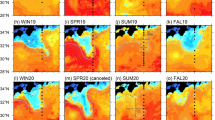Abstract
A reliable data set of Arctic sea ice concentration based on satellite observations exists since 1972. Over this time period of 36 years western arctic temperatures have increased; the temperature rise varies significantly from one season to another and over multi-year time scales. In contrast to most of Alaska, however, on the North Slope the warming continued after 1976, when a circulation change occurred, as expressed in the PDO index. The mean temperature increase for Barrow over the 36-year period was 2.9°C, a very substantial change. Wind speeds increased by 18% over this time period, however, the increase were non-linear and showed a peak in the early 1990s. The sea ice extent of the Arctic Ocean has decreased strongly in recent years, and in September 2007 a new record in the amount of open water was recorded in the Western Arctic. We observed for the Southern Beaufort Sea a fairly steady increase in the mean annual amount of open water from 14% in 1972 to 39% in 2007, as deduced from the best linear fit. In late summer the decrease is much larger, and September has, on average, the least ice concentration (22%), followed by August (35%) and October (54%). The correlation coefficient between mean annual values of temperature and sea ice concentration was 0.84. On a monthly basis, the best correlation coefficient was found in October with 0.88. However, the relationship between winter temperatures and the sea ice break-up in summer was weak. While the temperature correlated well with the CO2 concentration (r = 0.86), the correlation coefficient between CO2 and sea ice was lower (r = −0.68). After comparing the ice concentration with 17 circulation indices, the best relation was found with the Pacific Circulation Index (r = −0.59).









Similar content being viewed by others
References
Benner D (1996) NIC Arctic and Antarctic sea ice data. National Snow and Ice Data Center, Boulder, Colorado USA Digital media
Brown R (2000) Northern hemispheric snow cover variability and change, 1915–97. J Clim 13:2339–2355
Cavalieri D, Parkinson C, Gloersen P, Zwally HJ (2006) Sea ice concentrations from Nimbus-7 SMMR and DMSP SSM/I passive microwave data, [updated from 1996]. National Snow and Ice Data Center, Boulder, Colorado USA Digital media
Chapman W, Walsh J (1993) Recent variations in sea ice and air temperature at high latitudes. BAMS 74:33–48
Curtis J, Wendler G, Stone R, Dutton E (1998) Precipitation decrease in the western Arctic, with special emphasis on Barrow and Barter Island. Alaska Int J Climatol 18:1687–1707
Hartmann B, Wendler G (2005) The significance of the 1976 Pacific climate shift on the climatology of Alaska. J Clim 18:4824–4839
IPCC (2007) Climate change: the physical science basis—contribution of Working Group I to the Fourth Assessment Report. In: Solomon SD, Qin M, Manning Z, Chen M, Marquis KB, Averyt M, Tignor M, Miller HL (eds) Climate change: the physical science basis—contribution of Working Group I to the Fourth Assessment Report. Cambridge University Press, Cambridge/New York 996 pp
Kay JE, L’Ecuyer T, Gettelman G, Stephens G, O’Dell C (2008) The contribution of cloud and radiation anomalies to the 2007 Arctic sea ice extent minimum. Geophys Res Lett 35:L08503
Latif M, Barnett T (1996) Decadal climate variability over North America: dynamics and predictability. J Clim 9:2406–2434
Mantua N, Hare S, Zhang Y, Wallace J, Francis R (1997) A Pacific interdecadal climate oscillation with impact on salmon production. BAMS 78:1069–1079
Maslanik J, Serreze M, Agnew T (1999) On the record reduction in western arctic sea ice cover in 1998. Geophys Res Lett 26:1905–1908
Osterkamp T, Romanovski V (1999) Evidence for warming and thawing of discontinuous permafrost in Alaska. Permafr Periglac Process 5:137–144
Overland J, Adams J, Bond N (1999) Decadal variability of the Aleutian Low and its relation to high-latitude circulation. J Clim 12(5):1542–1548
Serreze M, Barry R (2006) The Arctic climate system. Cambridge University Press, 402 pp
Shulski M, Wendler G (2007) The climate of Alaska. University of Alaska Press, 202 pp
Stafford J, Wendler G, Curtis J (2000) Temperature and precipitation of Alaska: 50 year trend analysis. Theor Appl Climatol 67:33–44
Stone R (1997) Variations in arctic air temperature in response to cloud-radiative and dynamical interactions. JGR 102(D18):21769–21776
Stone R, Dutton E, Harris J, Longenecker D (2002) Earlier spring snow melt in Northern Alaska as an indicator of climate change. JGR 107(D10)
Trenberth K, Hurrell J (1994) Decadal atmosphere–ocean variations in the Pacific. Clim Dyn 9:303–319
Wallace J, Zhang Y, Bajuk L (1996) Interpretation of interdecadal trends in Northern Hemisphere surface air temperature. J Clim 9(2):249–259
Walsh J, Chapman W (1990) Short-term climatic variability of the Arctic. J Clim 3(2):237–250
Walsh J, Tanaka H, Weller G (1996) Wadati conference on global change and the polar climate. BAMS 77:237–250
Warren SG, Rigor R, Untersteiner N, Radionov V, Bryazgin N, Aleksandrov Y, Colony R (1999) Snow depth on Arctic sea ice. J Clim 12(6):1814–1829
Wendler G (2006) Climate of the polar realms. Chapter 5. In: Bridgman H, Oliver J (eds) The global climate system. Cambridge University Press, Cambridge, pp 131–169
Wendler G, Eaton F, Ohtake T (1981) Multiple reflection effects on irradiance in the presence of Arctic Stratus Clouds. JGR 86(63):2049–2057
Zhang T, Stamnes K, Bowling SA (1996) Impact of clouds on the surface radiative fluxes in the arctic and subarctic. J Clim 9(9):2110–2123
Zhang Y, Wallace J, Batista D (1997) ENSO-like interdecadal variability: 1900–93. J Clim 10:1004–1020
Acknowledgments
This study was supported by a grant of BP and Conoco-Phillips to the University of Alaska Foundation. We like to thank Vice Chancellor for Research C. Sharpton and Vice President for Academic Affairs D. Julius for making these funds available.
Author information
Authors and Affiliations
Corresponding author
Rights and permissions
About this article
Cite this article
Wendler, G., Shulski, M. & Moore, B. Changes in the climate of the Alaskan North Slope and the ice concentration of the adjacent Beaufort Sea. Theor Appl Climatol 99, 67–74 (2010). https://doi.org/10.1007/s00704-009-0127-8
Received:
Accepted:
Published:
Issue Date:
DOI: https://doi.org/10.1007/s00704-009-0127-8




